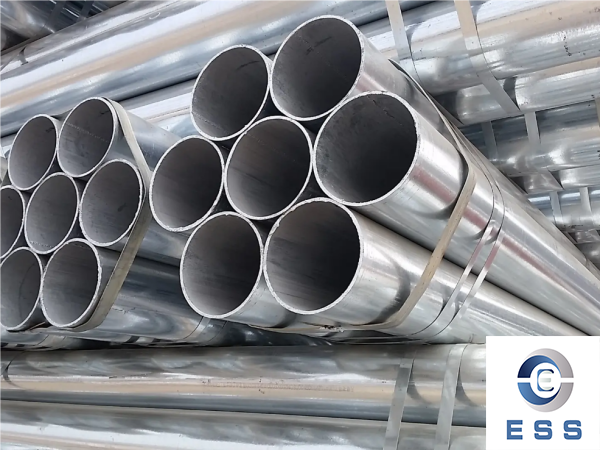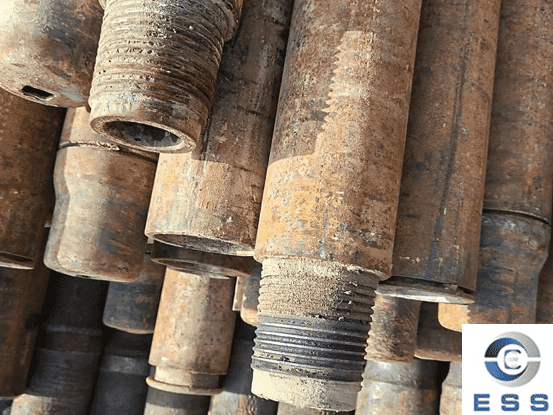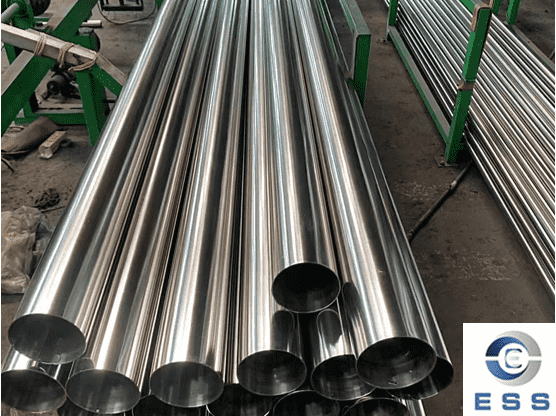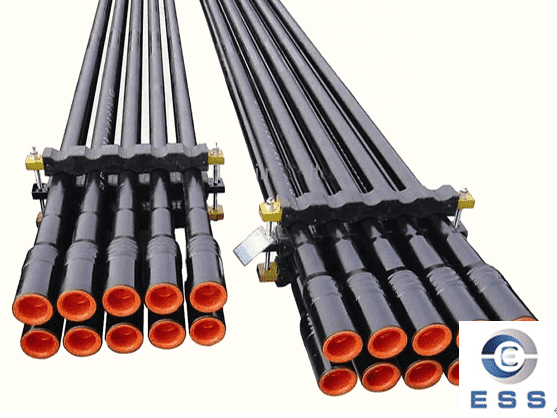Introduction to galvanized welded pipe
Galvanized pipe definition
Generally used galvanized steel pipes are hot-dip galvanized, while wire ducts used in electrical applications are cold-dip galvanized, and there are certain differences in color.
Cold plating--only the outer pipe wall is galvanized, hot plating--both the inside and outside are galvanized.
Galvanized welded pipes are hot-dip galvanized on the basis of
welded pipes (that is, melt the zinc in a zinc pot, then immerse the steel pipe in liquid zinc for a period of time, take it out, and then cool and blow dry). The inner and outer walls of the steel pipe have a layer of zinc at the same time. Attachment. Galvanized pipes are generally used for the transportation of low-pressure fluids (i.e. water, liquid gas).

Galvanized pipe standard classification
In order to improve the corrosion resistance of steel pipes, general steel pipes (black pipes) are galvanized.
Galvanized steel pipes are divided into two types: hot-dip galvanizing and electric steel zinc. Hot-dip galvanizing has a thick zinc layer and electro-galvanizing has low cost.
Oxygen blowing welded pipe: used as oxygen blowing pipe for steelmaking. Generally, small diameter welded steel pipe is used, with eight specifications ranging from 3/8 inch to 2 inch. Made of 08, 10, 15, 20 or Q195-Q235 steel strip. In order to prevent corrosion, some are aluminized.
In order to improve the corrosion resistance of steel pipes, general steel pipes (black steel pipes) are galvanized. Galvanized steel pipes are divided into two types: hot-dip galvanizing and electro-galvanizing. Hot-dip galvanizing has a thick zinc layer, while electro-galvanizing has low cost and the surface is not very smooth. Oxygen blowing welded pipe: used as oxygen blowing pipe for steelmaking. Generally, small diameter welded steel pipe is used, with eight specifications ranging from 3/8 to 2 inches. Made of 08, 10, 15, 20 or 195-Q235 steel strips, in order to prevent corrosion, they must be aluminized.
Most of the old houses use galvanized pipes, and the iron pipes used for gas and heating are also galvanized pipes. Galvanized pipes are used as water pipes. After a few years of use, a lot of rust and scale are produced in the pipes, and the yellow water flowing out not only pollutes the sanitary ware. , and mixed with bacteria that breed on the rough inner wall, corrosion causes excessive heavy metal content in the water, seriously endangering human health. In the 1960s and 1970s, developed countries in the world began to develop new pipes and gradually banned galvanized pipes. China's Ministry of Construction and four other ministries and commissions have also issued documents clarifying that galvanized pipes will be banned from 2000. Galvanized pipes are rarely used in cold water pipes in newly built communities after 2000, and galvanized pipes are used in hot water pipes in some communities.
Weight coefficient of galvanized welded pipe
Nominal wall thickness (mm) 2.0 2.5 2.8 3.2 3.5 3.8 4.0 4.5
Coefficient (c) 1.064 1.051 1.045 1.040 1.036 1.034 1.032 1.028
Note: The mechanical properties of steel are important indicators to ensure the final performance (mechanical properties) of steel. It depends on the chemical composition and heat treatment system of the steel. In steel pipe standards, tensile properties (tensile strength, yield strength or yield point, elongation), hardness and toughness indicators are specified according to different usage requirements, as well as high and low temperature properties required by users. Steel grade: Q215A; Q215B; Q235A; Q235B
Test pressure value/Mpa: D10.2-168.3mm is 3Mpa; D177.8-323.9mm is 5Mpa
Classification of galvanized pipes
Galvanized steel pipes are divided into cold-galvanized pipes and hot-galvanized pipes. The former has been banned, and the latter has been advocated by the country to be temporarily available.
hot dip galvanized pipe
Hot-dip galvanizing pipe reacts molten metal with an iron matrix to produce an alloy layer, thereby combining the matrix and the coating. Hot-dip galvanizing is to pickle the steel pipe first. In order to remove the iron oxide on the surface of the steel pipe, after pickling, it is cleaned in an aqueous solution of ammonium chloride or zinc chloride or a mixed aqueous solution of ammonium chloride and zinc chloride, and then sent to in a hot dip plating tank. Hot-dip galvanizing has the advantages of uniform coating, strong adhesion, and long service life.
cold galvanized pipe
Cold galvanizing is electro-galvanizing. The amount of galvanizing is very small, only 10-50g/m2. Its corrosion resistance is much worse than that of hot-dip galvanized pipes. Regular galvanized pipe manufacturers, in order to ensure quality, most do not use electro-galvanizing (cold plating). Only small businesses with small scale and old equipment use electro-galvanizing, and of course their prices are relatively cheaper. The Ministry of Construction has officially announced that cold-galvanized pipes with backward technology will be phased out, and cold-galvanized pipes will not be used as water and gas pipes in the future.
Hot-dip galvanized steel pipe: The steel pipe matrix undergoes complex physical and chemical reactions with the molten plating solution to form a corrosion-resistant zinc-iron alloy layer with a tight structure. The alloy layer is integrated with the pure zinc layer and the steel pipe matrix. Therefore, it has strong corrosion resistance.
Cold-dip galvanized steel pipe: The zinc layer is an electroplated layer, and the zinc layer is independently layered with the steel pipe matrix. The zinc layer is thin, and the zinc layer simply adheres to the steel pipe matrix and falls off easily. Therefore, its corrosion resistance is poor. In new residential buildings, it is prohibited to use cold-dip galvanized steel pipes as water supply pipes.
Galvanized welded pipe process
The production process of galvanized welded pipes has the following production steps:
a. Round steel preparation; b. Heating; c. Hot rolling and perforation; d. Cut off the head; e. Pickling; f. grinding; g. Lubrication; h. Cold rolling processing; i. Skim; j. Solution heat treatment; k. Straightening; l. cut pipe; m. Pickling; n. Product testing.
Technical requirements that galvanized pipes should meet
1. Brand and chemical composition
The grade and chemical composition of the steel used for galvanized steel pipes should comply with the grade and chemical composition of the steel used for black pipes specified in GB 3092.
2. Manufacturing method
The method of manufacturing the clarinet (furnace welding or electric welding) is chosen by the manufacturer. Galvanizing adopts hot dip galvanizing method.
3. Threads and pipe joints
3.1 For galvanized steel pipes delivered with threads, the threads should be machined after galvanizing. Threads should comply with YB 822.
3.2 Steel pipe joints shall comply with the requirements of YB 238; malleable iron pipe joints shall comply with the requirements of YB 230.
4. Mechanical properties The mechanical properties of steel pipes before galvanizing should comply with the regulations of GB 3092.
5. Uniformity of galvanized layer Galvanized steel pipes should be tested for uniformity of galvanized layer. Steel pipe samples are continuously immersed in copper sulfate solution
It must not turn red (copper-plated color) after 5 times.
6. Cold bending test: Galvanized steel pipes with a nominal diameter not larger than 50mm should be subjected to cold bending test. The bending angle is 90°, and the bending radius is 8 times the outer diameter. There is no filler during the test, and the welding seam of the sample should be placed on the outside or upper part of the bending direction. After the test, there should be no cracks or signs of zinc layer peeling off on the sample.
7. Hydraulic pressure test The hydraulic pressure test should be carried out on the black pipe, and eddy current flaw detection can also be used instead of the hydraulic pressure test. The size of the test pressure or eddy current flaw detection comparison sample should comply with the regulations of GB 3092.
①Tensile strength (σb)
During the stretching process, the maximum force (Fb) the sample endures when it breaks is the stress (σ) obtained by the original cross-sectional area (So) of the sample, which is called tensile strength (σb). The unit is N/mm2 (MPa). It represents the maximum ability of a metal material to resist damage under tension. The calculation formula is:
In the formula: Fb--the maximum force endured when the sample is broken, N (Newton); So--the original cross-sectional area of the sample, mm2.
②Yield point (σs)
For metal materials with yield phenomenon, the stress at which the sample can continue to elongate without increasing (remaining constant) force during the stretching process is called the yield point. If the force decreases, the upper and lower yield points should be distinguished. The unit of yield point is N/mm2 (MPa).
Upper yield point (σsu): the maximum stress before the specimen yields and the force decreases for the first time; Lower yield point (σsl): the minimum stress in the yield stage when the initial instantaneous effect is not considered.
The formula for calculating the yield point is:
In the formula: Fs--yield force (constant) during the tensile process of the sample, N (Newton) So--original cross-sectional area of the sample, mm2.
③Elongation after break (σ)
In the tensile test, the percentage of the increased length of the gauge length of the specimen after it is broken to the original gauge length is called elongation. Expressed by σ, the unit is %. The calculation formula is:
In the formula: L1--the gauge length of the specimen after breaking, mm; L0--the original gauge length of the specimen, mm.
④Area shrinkage (ψ)
In the tensile test, the percentage of the maximum reduction in the cross-sectional area at the reduced diameter after the specimen is broken and the original cross-sectional area is called the reduction of area. Expressed by ψ, the unit is %. Calculated as follows:
In the formula: S0--original cross-sectional area of the sample, mm2; S1--minimum cross-sectional area at the reduced diameter after the sample is broken, mm2.
⑤Hardness index
The ability of a metal material to resist the indentation of the surface by hard objects is called hardness. According to different test methods and application scope, hardness can be divided into Brinell hardness, Rockwell hardness, Vickers hardness, Shore hardness, microhardness and high temperature hardness. There are three commonly used hardnesses for pipes: Brinell, Rockwell, and Vickers hardness.
A. Brinell hardness (HB)
Use a steel ball or carbide ball of a certain diameter to press into the sample surface with the specified test force (F). After the specified holding time, remove the test force and measure the indentation diameter (L) on the sample surface. Brinell hardness value is the quotient obtained by dividing the test force by the surface area of the indented sphere. Expressed in HBS (steel ball), the unit is N/mm2 (MPa).
Galvanized welded steel pipes for low-pressure fluid transportation (hot-dip galvanized parts)
1. Uniformity of the galvanized layer: the steel pipe sample shall not turn red (copper color) when immersed in copper sulfate solution for 5 consecutive times.
2. Surface quality: The surface of galvanized steel pipes should have a complete galvanized layer. There should be no uncoated black spots and bubbles. Small rough surfaces and local zinc tumors are allowed.
3. Weight of galvanized layer: According to the requirements of the purchaser, galvanized steel pipes can be used to measure the weight of the zinc layer. The average value should not be less than 500g/square meter, and any sample should not be less than 480g/square meter.













 Eastern Steel Manufacturing Co.,Ltd not only improve product production and sales services, but also provide additional value-added services. As long as you need, we can complete your specific needs together.
Eastern Steel Manufacturing Co.,Ltd not only improve product production and sales services, but also provide additional value-added services. As long as you need, we can complete your specific needs together.










